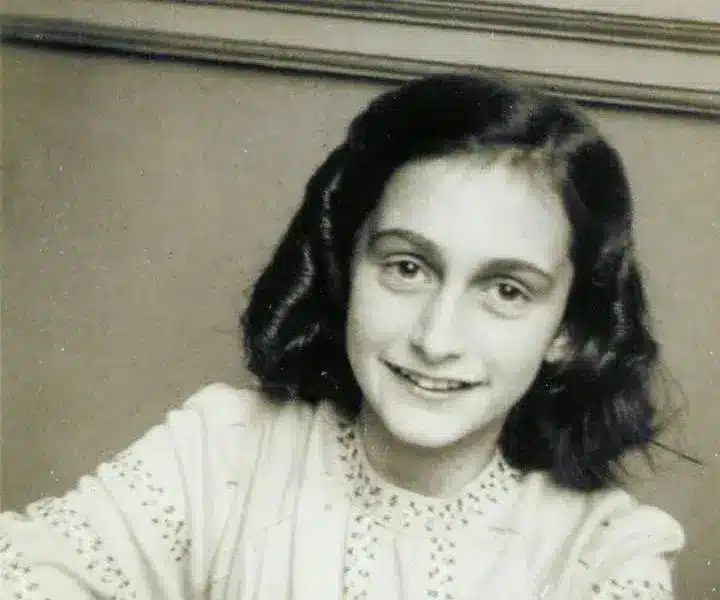Annelies Marie “Anne” Frank (12 June 1929 – February or March 1945), a German-Dutch diarist of Jewish heritage. One of the most discussed Jewish victims of the ugly Holocaust, she gained fame posthumously with the 1947 publication of The Diary of a Young Girl in which she documents her life in hiding from 1942 to 1944, during the German occupation of the Netherlands in World War II. It is one of the world’s best-known books and has been the basis for several plays and films.
Anne Frank was a Jewish girl who was killed in the Holocaust in 1945 at the age of 15, after having hidden from the Nazis in a secret annexe in Amsterdam for over two years. During her time in hiding, Anne Frank wrote a diary, in which she expressed her hopes, fears and ambitions for the future as well as what it was like to hide in fear of your life for all that time. After the war, her father Otto Frank, who miraculously survived Auschwitz concentration camp, made her diary into a book.
Early Life
Anne Frank was born on 12 June 1929 in Frankfurt, Germany, she lived most of her life in or near Amsterdam, Netherlands, having moved there with her family at the age of four and a half when the Nazis gained control over Germany.
In 1933 Anne’s family — her father, Otto, her mother, Edith, and her older sister, Margot—moved to Amsterdam from Germany following the rise of Adolf Hitler. In 1940 the Netherlands was invaded by Germany, which began to enact various anti-Jewish measures, one of which required Anne and her sister to enrol in an all-Jewish school the following year. Born a German national, she lost her citizenship in 1941 and thus became stateless. The following month Margot received an order to report to a labour camp. Facing arrest if she did not comply, the family went into hiding on 6 July 1942, moving into a “secret annexe” at Otto’s business in Amsterdam, the entrance to which was soon hidden behind a moveable bookcase. The Franks were later joined by four other Jews—Hermann and Auguste van Pels and their son, Peter, and Fritz Pfeffer—and were aided by several friends, including Miep Gies, who brought food and other supplies.
Diary: compilation and publication
On 12 June 1942, Anne received a red-and-white plaid diary for her 13th birthday. That day she began writing in the book: “I hope I will be able to confide everything to you, as I have never been able to confide in anyone, and I hope you will be a great source of comfort and support.” From the First World War, Otto’s life turned out to be the complete opposite to Adolf Hitler’s. There was on the one hand a man who went on to wreak unimaginable destruction across Europe. And on the other hand, there was Otto Frank, one man who having survived the Holocaust but lost his wife and children, was determined that future generations of children would not have to suffer the persecution and hatred that his own had. When Otto came back from the concentration camp and was given the heartbreaking news that his family had died. Otto, the only survivor of the Frank family, returned to Amsterdam after the war to find that her diary had been saved by his secretary, Miep Gies, in 1947, Otto made sure the diary was published so that everyone would know what had happened to his family. At the same, he fulfilled Anne’s wish to be a published author. Het Achterhuis, the first Dutch edition of Anne Frank’s diary, published in 1947, later translated into English as The Diary of a Young Girl, it was first published in Germany and France in 1950, and after being rejected by several publishers, and was first published in the United Kingdom in 1952. The first American edition, published in 1952 under the title Anne Frank: The Diary of a Young Girl, was positively reviewed. The book was successful in France, Germany, and the United States, but in the United Kingdom it failed to attract an audience and by 1953 was out of print. and has since been translated into over 70 languages. The title Anne Frank: “The Diary of a Young Girl” it included an introduction by Eleanor Roosevelt. By 1957 Anne’s diary had become famous all over the world and people were making pilgrimages to see her hiding place – an office and warehouse in the centre of Amsterdam. The building was old and becoming derelict and the council was going to knock it down and all that history was going to be lost. But Otto convinced the Mayor of Amsterdam and the council to save the building, so not only was the building saved but it was also turned into what has become one of the most famous museums in the world – the Anne Frank House. The Anne Frank House opened its doors on the 3rd of May 1960 – on this day one of the world’s most secret places became one of its most public. People visiting the Anne Frank House from all over the world are inspired by Anne’s words and come away understanding the dangers of prejudice and persecution and the importance of respecting our fellow human beings. In her diary, she wrote that she was determined to hold on to her dreams and ideals in the hope that the day would come when she would be able to carry them out. Anne’s diary was evidence of what he and his family had been through.
Written with insight, humour, and intelligence, the Diary became a classic of war literature, personalizing the Holocaust and offering a moving coming-of-age story. To many, the book was also a source of inspiration and hope. During such adversity, Anne poignantly wrote, “I still believe, in spite of everything, that people are really good at heart.”
Anne’s last diary entry was written on August 1, 1944. Three days later the secret annexe was discovered by the Gestapo, which had received a tip from Dutch informers. All the inhabitants were taken into custody. In September, the Frank family arrived at Auschwitz, though Anne and Margot were transferred to Bergen-Belsen the following month. In 1945 Anne as well as her mother and sister died of hunger and disease in a cold and frightening concentration camp.

